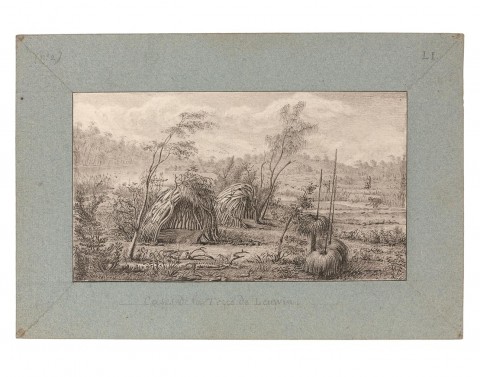CASES DE LA TERRE DE LEWIN (GÉOGRAPHE BAY, W.A.), probably June 1801
CHARLES-ALEXANDRE LESUEUR
pen and ink and graphite on laid paper
a framing mount of blue-grey paper applied over the paper sheet
98 x 175 mm (image)
158 x 235 mm (sheet)
inscribed with title on mount lower centre: Cases de la Terre de Lewin
inscribed upper left on mount: No 2
inscribed upper right on mount: LI
This view was not included in the first edition atlas of 1807, but was added by Freycinet in the second edition of 1824 as the second illustration on plate 31. Noted as C.A. Lesueur delint., J. Devilliers aqua forti, A. Delvaux sculpt.
See also especially Le Havre B:16028, 16031 &16032, in turn part of a series of clearly related sketched of the huts on the Vasse in June 1801
An extremely rare and exceptionally early original depiction of Western Australia, relating to the arrival of the Baudin voyage at the Vasse River near modern Busselton.
Péron best captured the mood among the crew and the savants when they first reached New Holland, describing how everyone who could be spared rushed ashore and made forays inland: the woods on the shores of the Vasse must have echoed with the French officers loudly tramping about in small parties of half-a-dozen or so, but of the actual inhabitants they saw very little, although a party which included Bernier and Maugé were “more fortunate” than that of Péron, having met with an old man who had told them in no uncertain terms to go home.
Although Péron’s investigation of what he termed a “bosquet religieux” on the banks of the Vasse would lead him to speculate on the religion of the region, he was dreadfully disappointed to miss having any personal interaction with the local Aborigines, and in his account therefore relied heavily on the notes of his friend Lesueur, who had been part of a group that had chased after a couple: the man had escaped into the forest, but the French had caught up with the pregnant woman, their clumsy approach terrifying her so much that she was literally rendered inanimate.
Lesueur had also, Péron continued, made some further investigations of his own, and one passage relates directly to the present work:
“Lesueur informed me that he had seen several huts of the natives, which were all built on the humid banks of the salt marshes that covered the shore on the right-side of the river; that they were roughly constructed of slender branches of trees stuck in the ground and fastened together at the points, somewhat like an arbour, and covered on the outside with the useful sort of bark which I have before noticed… In front of each of these huts were observed the remains of extinguished fires; and amongst the ashes some remnants of fishes, of kangaroos, and some beaks of wild swans. M. Lesueur had made a drawing of these miserable cabins, which he shewed me, and I was of opinion that it was impossible to find elsewhere more wretched habitations…” (Péron, Voyage of Discovery, p. 68).
Given the demanding pace Baudin set on their subsequent voyage north to Timor, this would be the most substantial investigation made by the French, although Freycinet on the little Casuarina did tidy up some nagging navigational questions when he sailed through these waters in 1803.
An engraving closely based on this scene was ultimately included in the second edition of the Baudin voyage published in 1824, where it was given the helpfully descriptive title “Nouvelle-Hollande: Terre de Leuwin, Étangs sales de la Rivière Vasse, Cabanes des Savages de la Baie du Géographe” and, importantly, was noted as having been drawn by Lesueur himself.
The beautifully realised scene includes five very small Aboriginal figures in the background (one at left, crouching in the reeds, with a visible fish-trap, and four hunting on the right). It is not quite like any of the other pencil sketches recorded by Bonnemains, although a long series (see particularly B:16026-16033) show distinctive similarities both in the style and structure of the huts. One of the more intriguing aspects of the present drawing is that it prominently includes the clump of Xanthorrhoea, which is not present in any of the sketches reproduced by Bonnemains, but which features on the finished plate.
One significant difference is in the rendering of the human figures. In both they are little more than outlines, but the original has a liveliness that has gone missing in the engraving where, for a start, the figure wading in the water not only seems to have no head, but is now missing the bird neatly caught on his spear (which is why the two tiny birds to his left are so clearly here making their escape, rather than flying towards the hunter as in the finished scene).
Although unsigned, the attribution to Lesueur is confirmed by the subject matter and style; the fact that all of the other related drawings in Le Havre are also by Lesueur; and that when it was finally published in 1824 the scene is noted as Lesueur “delint.”
